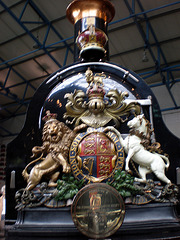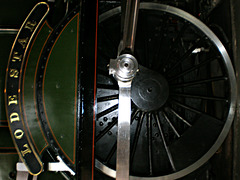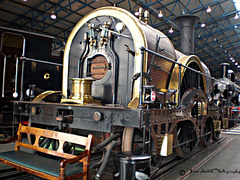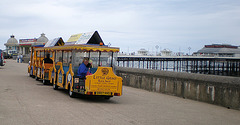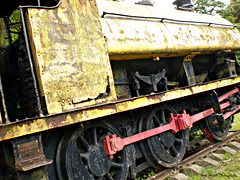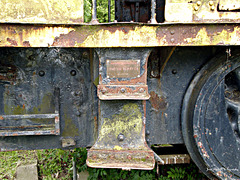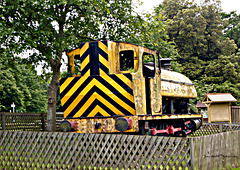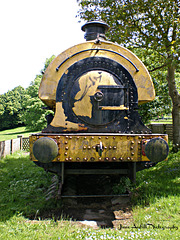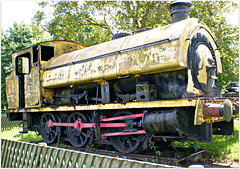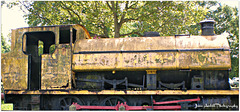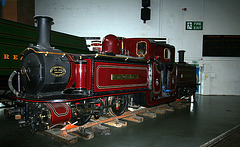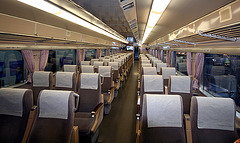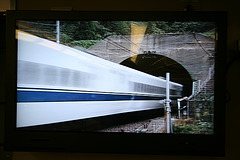╰☆☆June☆☆╮'s photos
P9170102
| |
|
P9170101
| |
|
P9170094
| |
|
|
P9170092
| |
|
Iron Duke (3)
| |
|
|
|
The prototype locomotive, Great Western, was built as a 2-2-2 locomotive in April 1846, but was soon converted to a 4-2-2 arrangement. The remainder of the class entered service between April 1847 and July 1855.
Locomotives of the Iron Duke class were extremely fast and had an estimated top speed of about 80 mph (133 km/h). They were used to haul the Flying Dutchman express train which, for several decades, was the world's fastest train. In 1852 the daily service from London Paddington Station to Exeter (194 miles) was achieved with an average speed of 53 mph (88 km/h); with the flatter section between London and Swindon covered at an average speed of 59 mph [1].
From about 1865, the Iron Duke Class was known as the Alma Class.
In May to July 1870, three locomotives (Great Britain, Prometheus and Estaffete) were extensively rebuilt with new frames and boilers, but retaining their original names. Following these, further locomotives were built to similar specifications, entering service between August 1871 and July 1888. These new locomotives are generally referred to as the Rover class. Although these locomotives took the names of withdrawn locomotives of the original design, they were not rebuilt from them like the first three, but entirely new locomotives (though it is believed that Rover, Swallow and Balaklava may have included some parts from the earlier locomotives of those names).
P7020020
| |
|
P7020019
| |
|
Steel works memorabilia
Steel works memorabilia
Steel works memorabilia
Steel works memorabilia
Steel works memorabilia
Steel works memorabilia
Steel works memorabilia
Napier Diesel Engine built 1961
| |
|
|
|
The British Rail Class 55 is a class of diesel locomotive built in 1961 and 1962 by English Electric. They were designed for the high-speed express passenger services on the East Coast Main Line between London King's Cross and Edinburgh. They gained the name "Deltic" from the prototype locomotive, DP1 Deltic, which in turn was named after its Napier Deltic power units.
Livingston Thompson. Festiniog Railway 1885
| |
|
|
|
Festiniog Railway.
In the years from 1847 to 1851 the Works was considerably developed by the construction of ferrous and non-ferrous foundries, a pattern making shop, a blacksmith's shop, a carpenter's shop, and an engine house in which a steam engine provided power for machinery in a sawmill, pattern shop and machine shops. In the 1870s further construction provided a paint shop, joiner's shop and erecting shop in which in 1879 and 1885 the double Fairlie engines Merddin Emrys and Livingston Thompson were built. Prior to 1915 the works employed about 30 men. During the Great War most of the works was used as a munitions factory (largely staffed by women) from 17 September 1915 until early in 1919. The fortunes of the railway and its works declined from the mid 1920's with total closure from March 1947 to September 1954.
Japanese Bullet train (3)
| |
|
|
|
The Shinkansen is a network of high-speed railway lines in Japan operated by four Japan Railways Group companies. Since the initial Tōkaidō Shinkansen opened in 1964 running at 210 km/h (130 mph), the network (2,459 km or 1,528 miles) has expanded to link most major cities on the islands of Honshū and Kyūshū with running speeds of up to 300 km/h (188 mph), in an earthquake- and typhoon-prone environment. Test run speeds have been 443 km/h (275 mph) for conventional rail in 1996, and up to a world record of 581 km/h (361 mph) for maglev trainsets in 2003.
Japanese Bullet train (2) Photo of the video
| |
|
The Shinkansen is a network of high-speed railway lines in Japan operated by four Japan Railways Group companies. Since the initial Tōkaidō Shinkansen opened in 1964 running at 210 km/h (130 mph), the network (2,459 km or 1,528 miles) has expanded to link most major cities on the islands of Honshū and Kyūshū with running speeds of up to 300 km/h (188 mph), in an earthquake- and typhoon-prone environment. Test run speeds have been 443 km/h (275 mph) for conventional rail in 1996, and up to a world record of 581 km/h (361 mph) for maglev trainsets in 2003.


